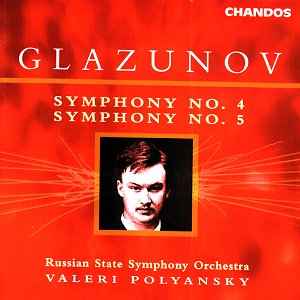
We too easily forget Glazunov's world-wide success. His symphonies in particular
had repeated performances during the 1890s and 1900s in the USA and especially
in the UK. Glazunov himself travelled widely to conduct these works. Sir
Henry Wood in London was a strong advocate and a staggering number of multiple
performances were given conducted by Sir Dan Godfrey at Bournemouth. Gradually
in the 1960s through the export of various Melodiya performances Glazunov's
star began to rise from the abyss into which it had sunk. Ivanov and Fedoseyev
had LPs issued in the UK via EMI. Later a reputedly very fine set (reckoned
by the Glazunov Society to be THE reference set and sadly unheard by me)
was recorded by Evgeny Svetlanov and these were issued on Melodiya CDs during
the early 1990s. Regrettably they seem to have disappeared now. The
Rozhdestvensky set on Olympia is well worth hearing but the level of aural
refinement is not a patch on the present recordings.
No. 4 is, unusually for Glazunov, in only three movements. The first has
a fine rangy oriental romance which meets Tchaikovskian delirium. Indeed
Tchaikovsky is often a presence in both symphonies. The second movement is
a buzzing and dancing scherzo where icy woodwind chatter in carefree delight.
The speed is so fast that I thought that co-ordination slipped in the first
couple of moments. These doubts were soon banished as the balletic music
self kindled in joyous celebration worthy of Glazunov's more popular ballet
The Seasons. The finale's trampling Cossack charge is all excitement
and grandeur. The brass echo-effects (horns to trumpets) are truly exhilarating.
Symphony No. 5 is one of Glazunov's most popular symphonies. It has catchy
themes and is amongst the most dramatic of the nine. In Polyansky's hands
however the broad approach sometimes teeters over the edge into languor.
This is noticeable in the first movement and somewhat in the fourth and final
movement. At these points the performance would have benefited from a tauter
and snappier direction. Tchaikovsky's 5th symphony is a clear
influence with its admixture of ballet and drama. The second movement is
again balletic resorting to flashy display which conveys sincerity and is
not at all meretricious. The big romantic theme may well have inspired
Prokofiev's Classical Symphony (1914). Listen carefully you may be
surprised. The delicate emotional pastels of the andante are glowingly done.
The finale's Russian Easter Festival is as explosive as Tchaik 4 but here
is taken with a rather broader pacing. It could have taken more accelerator.
That said the lightning flashes and the thunder crashes in a contest in which
richly Rimskian darkness meets Tchaikovsky's emotional fever. Another familiar
voice (at 2:33) is Rachmaninov's First Symphony (the disastrous premiere
of which was presided over by Glazunov). In the crashing finale Polyansky
recaptures the nervy invigoration.
Some reservations then but my how Polyansky and his orchestra articulate
this music. Chandos have a winner on their hands in terms of the subtly-lit
strength of this pair of performances. I restlessly await the remaining
symphonies and especially numbers 6 and 8. Will they be on a single disc?
A series to follow closely.
Reviewer
Rob Barnett

